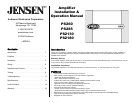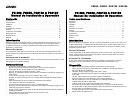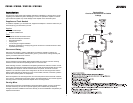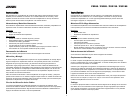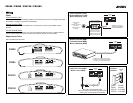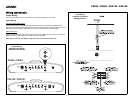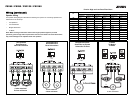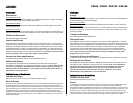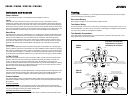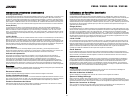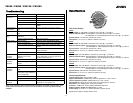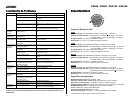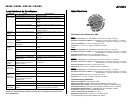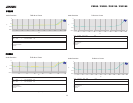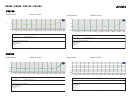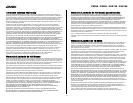
PS260 / PS285 / PS2130 / PS2180
11
Troubleshooting
Note: If the protection light is activated with no speakers connected to the amplifier, and
all the power connections are correct, this would indicate an internal problem with the
amplifier.
Problem Possible Cause Corrective Action
Amplifier does
not turn on
No power to +12V terminal Check fuse(s)
No power to REM terminal Check head unit fuse(s) and wiring
Blown main fuse at battery Replace fuse and identify cause of failure
Blown fuse at amplifier Replace fuse and identify cause of failure
Faulty ground Reground main power ground to bare metal
chassis
Volume control
too sensitive
Input level control adjusted too
high
Readjust the input level (refer to page 9)
Distorted sound Input level control adjusted too
high
Readjust the input level (refer to page 9)
Blows fuse(s) at
amp
Power wires connected
backwards
Reconnect power wires properly
Internal problem with amp Take unit for service
Engine noise /
Alternator whine
Ground loop(s) Use good quality shielded RCA cables
Faulty ground at amp Reground amp to clean bare metal chassis
Faulty ground at head unit Reground head unit to clean bare metal
chassis
Inductive coupling Reroute RCA and/or speaker wires away from
factory harnesses
Input level on amp set too high Readjust input level (refer to page 9)
Thermal
protection
activated
Amplifier driving 2 ohm load or
bridged mono for long
durations
If the amplifier “thermals” frequently while
driving subwoofers, a fan may need to be
installed to keep amp cool
Short circuit
protection
activated
Blown speakers Check all speakers
Speaker wire(s) shorting to
ground
Check for faulty wiring
Defective crossover Faulty passive crossover
Low impedance
protection
activated
Amp connected to improper
load
Check speaker connections
Amp will not drive a 2 ohm
mono load, 4 ohm minimum in
mono configuration
Verify that speakers are connected properly
Speakers defective/blown Check speakers
Faulty passive crossovers Check crossovers
Poor bass
response
Speakers out of phase Check speaker polarity; reverse the
connection to one speaker only
Specifications
CEA Power Ratings
PS260
Power Output: 57 watts RMS X 2 channels into 4-ohms @ < 1% THD+N
Additional Power Output: 75 watts RMS X 2 channels into 2-ohms @ < 1% THD+N
155 watts RMS X 1 channel (Bridged mono) into 4-ohms @ < 1% THD+N
Dynamic Power: 114 watts X 2 channels into 4-ohms
Dimensions: 7" X 12" X 2 ¼" (180mm X 302mm X 55.5mm)
PS285
Power Output: 80 watts RMS X 2 channels into 4-ohms @ < 1% THD+N
Additional Power Output: 105 watts RMS X 2 channels into 2-ohms @ < 1% THD+N
215 watts RMS X 1 channel (Bridged mono) into 4-ohms @<1% THD+N
Dynamic Power: 160 watts X 2 channels into 4-ohms
Dimensions: 10" X 12" X 2 ¼ " (250mm X 302mm X 55.5mm)
PS2130
Power Output: 123 watts RMS X 2 channels into 4-ohms @ < 1% THD+N
Additional Power Output: 165 watts RMS X 2 channels into 2-ohms @ < 1% THD+N
345 watts RMS X 1 channel (Bridged mono) into 4-ohms @ <1% THD+N
Dynamic Power: 246 watts X 2 channels into 4-ohms
Dimensions: 12" X 12" X 2 ¼" (300mm X 302mm X 55.5mm)
PS2180
Power Output: 180 watts RMS X 2 channels into 4-ohms @ < 1% THD+N
Additional Power Output: 220 watts RMS X 2 channels into 2-ohms @ < 1% THD+N
450 watts RMS X 1 channel (Bridged mono) into 4-ohms @ < 1% THD+N
Dynamic Power: 360 watts X 2 channels into 4-ohms
Dimensions: 15" X 12" X 2 ¼" (381mm X 302mm X 55.5mm)
General Specifications
Frequency Response: 10Hz to 50kHz (-3dB)
Signal to Noise Ratio: 100dBA below reference. (Reference: 1 watt, 4-ohms)
Channel Separation @ 1kHz: <60dB (Reference: 1 watt, 4-ohms)
Input Sensitivity: 300mV to 8V for full power output at clipping (1% THD+N)
Bass Boost: 0 to +18dB @ 45Hz, continuously variable
Crossover: 12dB/octave, 40Hz to 400Hz, Butterworth alignment
Reference Supply Voltage for rated power: 14.4VDC
Power Supply: 14.4VDC, (11 to 16VDC allowable), negative ground
Specifications subject to change without notice.



